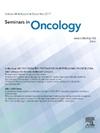多发性骨髓瘤:对潜在机制的洞察,诊断和治疗方式的进展
IF 2.5
3区 医学
Q2 ONCOLOGY
引用次数: 0
摘要
多发性骨髓瘤(MM)的特点是骨髓中产生抗体的终末分化浆细胞的恶性增殖和积累。MM的潜在遗传原因非常复杂,涉及无数关键基因的功能丧失,特别是那些涉及DNA复制保真度和修复的基因。强调MM突变的重要遗传事件包括大规模染色体畸变、局部遗传改变、DNA修复机制缺陷、点突变以及激活诱导脱氨酶(AID)、载脂蛋白B mRNA编辑酶和催化多肽(APOBEC)等酶的致突变活性。尽管治疗方案有了很大的改善,但MM病对大多数患者来说仍然是无法治愈的,死亡率很高。值得注意的是,MM的诊断延迟可能通过多种机制间接导致临床结果恶化和治疗反应性降低。MM的诊断主要依赖于患者样本的组织病理学变化和分子谱。在过去的几十年里,MM的诊断和治疗方法的新方法已经发明。总之,疾病认识、诊断和新的有效治疗干预措施的进步,极大地帮助减缓和/或阻止了大量患者的疾病进展,从而提高了总生存率。本文综述了MM的遗传原因、临床表现、诊断进展和新的治疗干预措施,包括针对复发/难治性MM的有效药物组合。本文章由计算机程序翻译,如有差异,请以英文原文为准。
Multiple myeloma: Insights into underlying mechanisms, advances in diagnostic and therapeutic modalities
Multiple myeloma (MM) is characterized by malignant proliferation and accumulation of terminally differentiated antibody-producing plasma cells in bone marrow. The underlying genetic causes of MM are highly complex, involving the loss of function in a myriad of crucial genes, especially those involved in DNA replication fidelity and repair. The important genetic events underscoring MM mutagenesis entail large-scale chromosomal aberrations, localized genetic changes, defective DNA repair mechanisms, point mutation, and mutagenic activity of enzymes such as activation-induced deaminase (AID) and apolipoprotein B mRNA editing enzyme, and catalytic polypeptide (APOBEC). Despite considerable improvement in treatment regimen, MM disease remains incurable for majority of patients with very high mortality. Notably, delay in diagnosis of MM could indirectly contribute to the worse clinical outcomes and lower treatment responsiveness through several mechanisms. Primarily, MM diagnosis relies on histopathological changes and molecular profiling of the patient’s sample. In the past decades, new methods of MM diagnosis and therapeutic approaches have been invented. Together, advances in disease understanding, diagnosis, and novel effective therapeutic interventions have substantially helped slow down and/or arresting the disease progression in the large number of patients, thereby increasing overall survival. This review discusses the genetic causes of MM, clinical presentation, advances in diagnosis, and new therapeutic interventions, including combinations of effective agents targeting relapse/refractory MM.
求助全文
通过发布文献求助,成功后即可免费获取论文全文。
去求助
来源期刊

Seminars in oncology
医学-肿瘤学
CiteScore
6.60
自引率
0.00%
发文量
58
审稿时长
104 days
期刊介绍:
Seminars in Oncology brings you current, authoritative, and practical reviews of developments in the etiology, diagnosis and management of cancer. Each issue examines topics of clinical importance, with an emphasis on providing both the basic knowledge needed to better understand a topic as well as evidence-based opinions from leaders in the field. Seminars in Oncology also seeks to be a venue for sharing a diversity of opinions including those that might be considered "outside the box". We welcome a healthy and respectful exchange of opinions and urge you to approach us with your insights as well as suggestions of topics that you deem worthy of coverage. By helping the reader understand the basic biology and the therapy of cancer as they learn the nuances from experts, all in a journal that encourages the exchange of ideas we aim to help move the treatment of cancer forward.
 求助内容:
求助内容: 应助结果提醒方式:
应助结果提醒方式:


